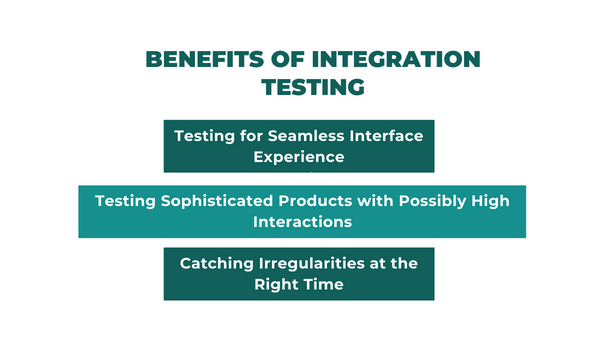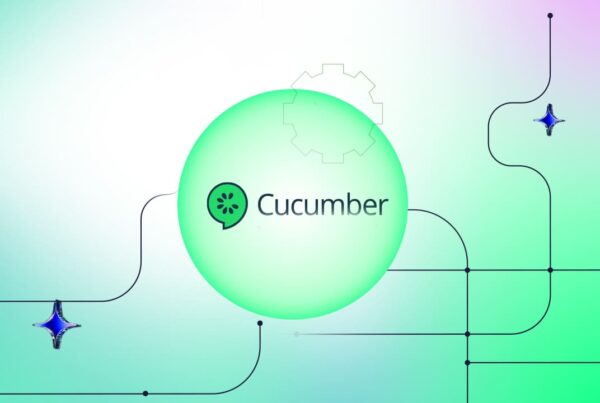What is Integration Testing? A Comprehensive Guide

Integration testing follows unit testing and precedes system testing, forming an essential bridge in the software development lifecycle. Developers can detect and rectify integration issues early, significantly reducing the risk of complex problems at later stages. This testing can be approached module by module, following a sequence that ensures comprehensive coverage of all integration scenarios.
- What is integration testing?
- What does integration testing involve?
- What Are the Types of Integration Testing?
- Integration Testing Phase
- How To Do Integration Testing
- Best Practices for Integration Testing
- Benefits of integration testing
- The difference between integration testing and acceptance testing
- ACCELQ For Integration Testing
What is Integration Testing?
What is integration testing? It is a systematic technique to evaluate a software application's interface and interaction between integrated units or modules. This testing is crucial in identifying and addressing faults that may arise when different software units, previously tested individually, are combined. The primary focus is to ensure the correctness and efficiency of these interactions, thereby guaranteeing the software functions as a cohesive whole.
- The software bodes well with the environment it’s designed to function in
- Something doesn’t break with a new update or upgrade
- The code is compatible with the libraries or other dependencies
- The logical interaction within the modules of an application is as expected
- Inter-module communication is formatted correctly
SUGGESTED READ - 15 Types of Software Testing Every QA Must Know About
What does integration testing involve?
Integration testing is indispensable for several reasons:
- Early Detection: Integration Testing helps catch interface and interaction problems between modules in the early stage. This early detection is key in preventing minor issues from escalating into major setbacks.
- Reliability: By testing how different units work together, Integration Testing is instrumental in reinforcing the dependability of the entire software system. It’s about ensuring every piece fits and functions as it should.
- Cost-Effective: Addressing and resolving issues during Integration Testing can significantly reduce costs. Fixing problems at this stage is far more economical than dealing with them after the software has been deployed.
What Are the Types of Integration Testing?
Each project requires a different approach and depends on unique characteristics and requirements. Here are the various integration tests and an example of how they cater to the different aspects.
1. Big-Bang Integration Testing
Big-Bang Integration Testing combines all modules at once after individual module testing. This method is straightforward but can be challenging for large systems due to the complexity of isolating errors.
Example
A simple calendar app with modules for displaying dates, setting reminders, and user notifications. In Big-Bang Integration Testing, all these modules would be integrated and tested simultaneously to ensure they work together seamlessly.
2. Bottom-Up Integration Testing
It starts with integrating and testing lower-level modules before moving to higher-level modules. It often uses test drivers to simulate higher-level modules.
Example
Consider a food delivery app. The testing would start with the restaurant listing module, then integrate and test the order processing module, and finally, the user interface for order placement would be tested and integrated.
3. Top-Down Integration Testing
Begins with high-level modules and progressively integrates and tests lower-level modules. It typically requires the use of stubs to simulate the functionality of lower-level modules.
Example
Testing would start with the user interface module in an email client application. Stubs might be used to simulate the sending and receiving email functionalities, which are then integrated and tested in subsequent steps.
4. Mixed Integration Testing (Sandwich Approach)
Mixed Integration Testing, or the Sandwich Approach, combines top-down and bottom-up methods. It's particularly useful for large projects with multiple layers.
Example
For a complex CRM system, the testing could start simultaneously at the user interface level (top-down) and the database level (bottom-up), meeting in the middle at the business logic layer.
5. Incremental Integration Testing
Incremental Integration Testing involves integrating and testing modules step by step rather than all at once. This approach helps in isolating and fixing errors more efficiently.
Example
Start by integrating and testing the task creation module in a project management tool. Once it's working flawlessly, integrate the task assignment module, test it, and so on, until the entire system is integrated and tested.
Integration Testing Phase
This phase is crucial in the software development lifecycle. It involves a systematic approach where modules are gradually combined and tested for functionality, data flow, and error handling after unit testing. The integration tests phase is iterative, often requiring multiple rounds of testing to ensure all components interact correctly.
How To Do Integration Testing
- Identify Components: Recognize the components that need integration, like frontend, backend, and databases.
- Develop a Test Plan: Outline scenarios and test cases for validating integration points.
- Set Up Test Environment: Mirror the production environment to ensure accurate test results.
- Execute Tests: Start with critical scenarios, logging defects for analysis.
- Analyze Results: Work with developers to address any identified issues.
- Repeat Testing: Ensure changes are successful and the application functions as expected.
Best Practices for Integration Testing
It's important to focus on strategies that enhance the effectiveness and efficiency of using integration testing tools. Here are some detailed best practices:
1. Comprehensive Test Planning
Before beginning integration testing, develop a comprehensive test plan. This plan should outline the scope, approach, resources, schedule, and specific test cases. Identifying the critical integration points and prioritizing them in the testing process is crucial.
2. Incremental Testing Approach
Adopt an incremental approach to integration testing. This means integrating and testing modules one at a time or in small groups rather than all at once. This approach helps isolate defects more easily and allows for more focused testing.
3. Continuous Testing and Integration
Incorporate integration testing as a part of the continuous integration and continuous deployment (CI/CD) pipeline. This ensures early identification and is addressed as soon as they arise. This practice reduces the risk of major integration failures at later stages.
4. Automated and Manual Testing Balance
While automation can save time and reduce errors in repetitive tests, manual testing is invaluable for exploratory tests and for areas where human judgment is crucial.
5. Test Environment that Reflects Production
This includes hardware, software, network configurations, and any external interfaces. Testing in an environment that closely resembles the real-world scenario can significantly improve the test results reliability.
6. Effective Communication and Collaboration
Developers, testers, and operations teams should work closely to understand the dependencies and interfaces between modules, which is crucial for effective integration testing.
7. Regular Documentation and Reporting
Keep detailed documentation of the test cases, test results, and any issues found. Regular reporting and documentation help track testing progress and make informed decisions throughout the development lifecycle.
8. Focus on Error Handling and Recovery
Pay special attention to how the system handles errors during integration testing. Check how integrated units respond to incorrect data or unexpected operational conditions. This helps in ensuring the robustness and stability of the application.
What Are the Benefits of Integration Testing?
If done correctly and thoroughly, integration tests can ensure that the system works as expected while driving the time to market. To that end, it bodes well to consider the following benefits that integration testing can offer:

Testing Sophisticated Products with Possibly High Interactions
Consider healthcare or financial products; they’re complex, making testing them a daunting task. For example, patients, doctors, and insurance companies across vast geographies might use the healthcare product.
Likewise, the financial product might be used directly or indirectly by several other stakeholders in the ecosystem. Naturally, the test scenarios, combinations, and inputs would be mind-boggling.
To accommodate such a test effort, it’s essential to have an integration testing approach that can simultaneously support testing logicality between multiple modules. When that happens, it’s easier to pick scenarios and loops by their effects on the overall system.
Testing for Seamless Interface Experience
Since the integration tests focus on testing the data flow between modules, it’s feasible to test for flawless experiences by ensuring that the overall system looks good to the user. This also makes it easier to detect flaws in the interface between components.
And when that happens, it’s relatively straightforward to find irregularities such as:
- Data integrity errors
- Invalid data or mismatched data
- Incorrect use-cases
- Errors in logic
- Broken APIs or modules
Catching Irregularities at the Right Time
With DevOps and Agile in full swing, there’s an increasing need to track inconsistencies as they happen. It’s imperative since the issues encountered late in the game often have cascading consequences on modules and the associated subsystems.
The QA professionals tasked with integration testing identify inconsistencies and errors as early as possible. This helps halt the impact on the system and brings the project back on track faster.
Integration Testing vs. Acceptance Testing
As the name suggests, acceptance testing is a way to prove that the system works as expected given specifically defined scenarios. This “expectation” is based on the user requirements. And that makes acceptance testing extravagantly user-centric.
But because of synonymous definitions, integration and acceptance testing methods are often confused with each other. Following is a brief explanation of the difference.
| Integration Testing | Acceptance Testing | |
| Principle | Testing the logical interaction between different modules. | Testing the functional adherence of a system to the client’s requirements. |
| Types | Incremental and non-incremental testing (big bang). | Alpha and beta testing. |
| Time | Performed early, even when the features are in development. | Performed after all the components are ready to function as a system. |
ACCELQ For Integration Testing
As we conclude our exploration of Integration Testing, it's evident that this phase is more than just a procedural step. It's a critical element that ensures software systems seamless functionality and robustness. Integration Testing not only identifies discrepancies between modules but also paves the way for delivering high-quality software that meets user expectations and withstands the complexities of real-world applications.
Embracing ACCELQ for your Integration Testing needs means stepping into a world where accuracy, speed, and efficiency are not just goals but realities. It's about ensuring that every piece of your software puzzle fits perfectly, delivering a seamless and flawless user experience. Explore ACCELQ today and take the first step towards seamless, efficient, and effective software testing.
Yuvarani Elankumaran
Technical Consultant at ACCELQ
Yuvarani Elankumaran is a highly skilled technical consultant at ACCELQ. With over a decade of experience in the field of Test Automation, Yuvarani is a seasoned professional who is well-versed in a variety of programming languages and automation frameworks.
Discover More
 Gherkin Syntax: Format, Language & Gherkin Test in Cucumber
Gherkin Syntax: Format, Language & Gherkin Test in Cucumber
Gherkin Syntax: Format, Language & Gherkin Test in Cucumber
 Cucumber in Test Automation: Implementation, Challenges, and Future Trends
Cucumber in Test Automation: Implementation, Challenges, and Future Trends
































